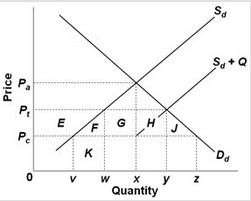An advantage of the decision tree is that
A) it eliminates the need for calculating the cost of capital.
B) it eliminates the need for calculating probabilities.
C) it causes the analyst to consider important events that may occur in the course of the project, and decisions and actions that may have to be undertaken.
D) All of the above
C
You might also like to view...
Use the following graph, where Sd and Dd are the domestic supply and demand for a product and Pc is the world price of that product, to answer the next question. Sd + Q is the product supply curve after an import quota is imposed. A quota of y?w will
Sd + Q is the product supply curve after an import quota is imposed. A quota of y?w will
A. increase the revenues of domestic producers by areas E + F + G + H + J. B. increase the revenues of domestic producers by areas E + F + K. C. lower domestic price and increase domestic consumption. D. increase the revenues of domestic producers by areas G + H.
An increase in the demand for peanuts due to changes in consumer tastes, accompanied by an increase in the supply of peanuts as a result of favorable growing conditions, will result in
A) an increase in the equilibrium price of peanuts and no change in the equilibrium quantity. B) an increase in the equilibrium quantity of peanuts; the equilibrium price may increase or decrease. C) an increase in the equilibrium price of peanuts; the equilibrium quantity may increase or decrease. D) an increase in the equilibrium quantity of peanuts and no change in the equilibrium price.
Roger and Brian have a discussion about cost minimization in firms during a recession. Roger stresses that company can reduce its costs by paying workers lower wages during a recession
a. Brian disagrees and argues that a company cannot reduce wages as price levels and wages do not adjust easily in the short run. Who do you think is correct? Give reasons to support your answer.
The higher the level of output, the farther ________ the isoquant will lie.
A. down and to the right B. up and to the left C. up and to the right D. down and to the left